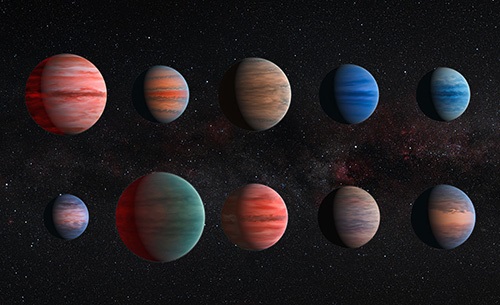December 14, 2015
By Tim Stephens
A survey of 10 hot, Jupiter-sized exoplanets conducted with NASA's Hubble and Spitzer space telescopes has enabled scientists to figure out why some of these worlds appear to have less water than expected.
The results of the survey showed that the atmospheres of those "hot Jupiter" planets with faint water signals also contained clouds and haze that can hide evidence of water. Hot Jupiters that appear cloud free, however, show strong signs of water. The findings were published December 14 inNature.
"Our results suggest it's simply clouds hiding the water from prying eyes, and therefore rule out dry hot Jupiters," explained coauthor Jonathan Fortney, professor of astronomy and astrophysics at UC Santa Cruz. "The alternative theory to this is that planets form in an environment deprived of water, but this would require us to completely rethink our current theories of how planets are born."
New insights
The study offers new insights into the wide range of planetary atmospheres in our galaxy and how planets are assembled.
"I'm really excited to finally see this wide group of planets together, as this is the first time we’ve had sufficient wavelength coverage to compare multiple features from one planet to another," said lead author David Sing of the University of Exeter, UK. "We found the planetary atmospheres to be much more diverse than we expected."
Of the few thousand planets discovered orbiting other stars, a subset are known as hot Jupiters, gaseous planets with characteristics similar to those of Jupiter but that orbit very close to their stars, making them blistering hot.
Hubble has only explored a handful of hot Jupiters because they are lost in the glare of their host stars. The wavelength range has been limited to studies in optical light. These initial studies found several planets to hold less water than expected, raising a puzzle as to why they look "dry."
Catalog of exoplanets
The international team of astronomers has tackled the problem by making the largest-ever spectroscopic catalog of exoplanet atmospheres. The team used multiple observations from Hubble to study the planets across an unprecedented range of wavelengths.
All of the planets follow orbits that have them pass in front of their parent star, as seen from Earth. During this so-called transit, some of the starlight travels through the planet's outer atmosphere. "The atmosphere leaves its unique fingerprint on the starlight, which we can study when the light reaches us," explained coauthor Hannah Wakeford of NASA Goddard Space Flight Center. These fingerprints allowed the team to extract the signatures from various elements and molecules — including water — and distinguish between cloudy and cloud-free exoplanets.
According to Fortney, the scorching temperatures on these hot Jupiters mean that their clouds are very different from those on Earth. Instead of water vapor, clouds on the hottest planets are likely to consist of liquid iron droplets. "These are exotic clouds on exotic planets," he said.
The study of exoplanetary atmospheres is currently in its infancy, with only a handful of observations taken so far. Hubble’s successor, the James Webb Space Telescope (JWST), will open a new infrared window on the study of exoplanets and their atmospheres.















